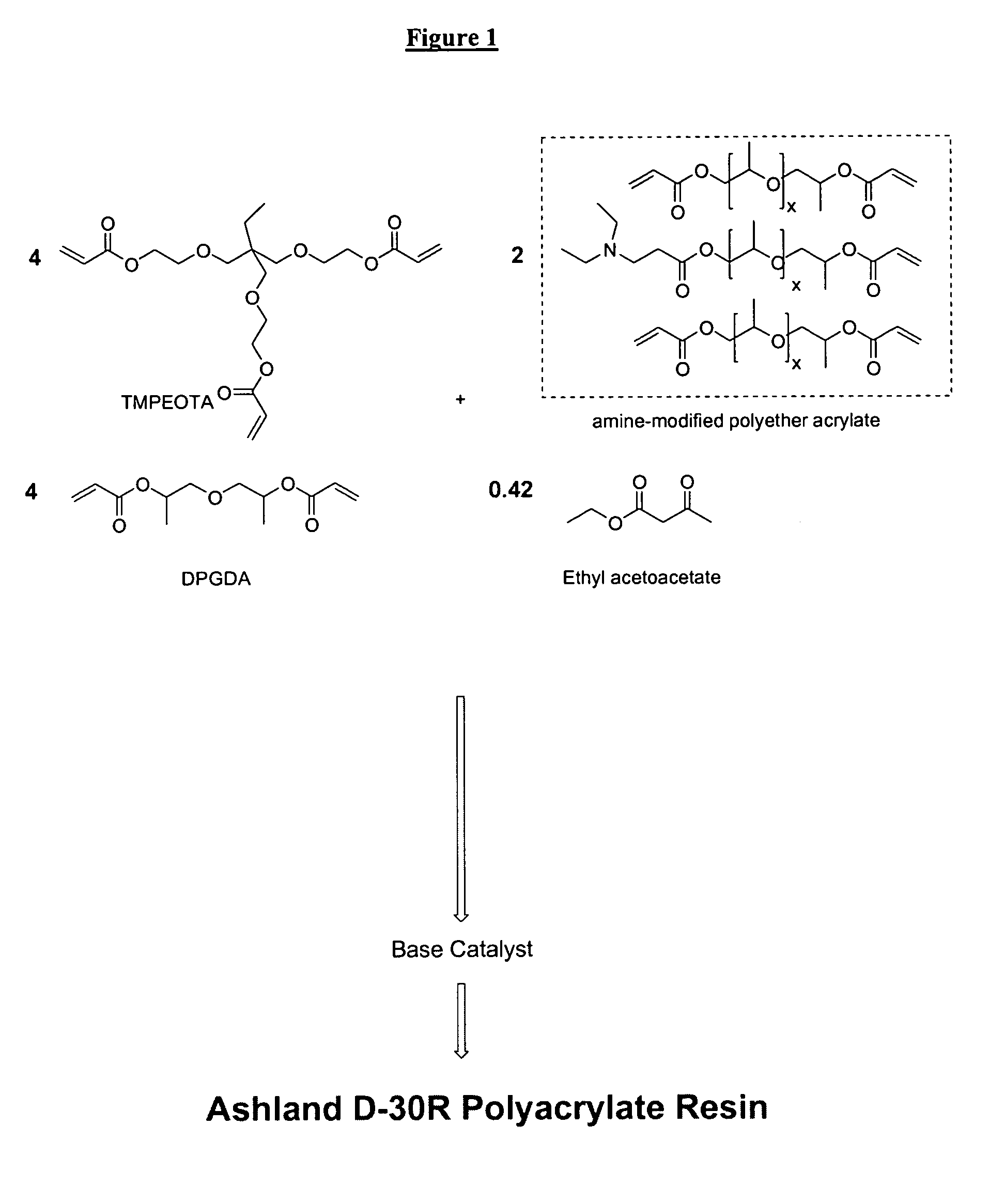Multifunctional acrylate oligomers as pigment grinding vehicles for radiation-curable ink applications
a technology of acrylate oligomers and pigment grinding vehicles, which is applied in the direction of pigment pastes, coatings, pigments, etc., can solve the problems of limiting the applicability of conventional oligomers, requiring substantial amounts of various photoinitators, and being toxic to the environment, so as to reduce the amount of time needed, excellent pigment wetting properties, and excellent dispersibility
- Summary
- Abstract
- Description
- Claims
- Application Information
AI Technical Summary
Benefits of technology
Problems solved by technology
Method used
Image
Examples
example 2
Comparative Evaluation of the Pigment Dispersions
[0053]
TABLE IVNPIRI grind gauge ObservationsVis-cosity#Grind SampleResin(Poise)ScratchPepper1UCB-b-081103-02EbecrylN.D.7Lots.(Standard)34112UCB flex-b-081203-01ViaFlex81.00light to165moderate3UCB Screen-b-08110305ViaScreen331.5*4none5154135-b-081103-02Ashland66.70lotsD-30R5136-b-071603-027008-13652.70none6137-b-071603-037008-13740.70none7138-b-071603-047008-13863.70none8139-b-071603-057008-13964.20none9140-b-071603-067008-14040.00none10110-b-073103-017001-11066.00none117001136-b-073103-027001-13641.00none12106-b-073103-027001-10660.70none13191-b-073103-037001-19159.00none14706901-081503-027069-00168.50slightViscosity (P) determined at 300 RPM or 100 RPM (*).
[0054]
TABLE 5Color Development in Pigment DispersionsClear bleach testGlossTint test#Lab(60°)Lab157.21−30.31−40.2983.574.79−20.6−21.94256.76−30.38−40.1784.377.96−19.77−21.15361.06−32.28−36.9287.178.07−19.89−21.16458.28−31.07−39.2383.476.44−20.49−22.24557.12−30.79−408476.78−20.35−21...
example 3
Comparative Benchmarking of White Pigment Dispersions
[0057]A white pigment, titanium dioxide (DuPont R-706®) was ground at 70% loading in all resins using a 3-roll mill using formulations specified in Table VI.
[0058]
TABLE VIGeneric formulation for white pigment dispersionComponentDescriptionParts (w / w)ResinResin vehicle18.0R-706White Pigment42.0
[0059]
TABLE VIIResin DefinitionsResinVis-vehicleDescriptioncosityEbecrylepoxy acrylate498.703411ViaflexUCB flexo grinding vehicle26.50165ViascreenUCB screen grinding vehicle139.005157008-135TMPEOTA / DPGDA / 0.50 polyester acrylate / EAA10.46(Ashland2.4D-30R)7001-1063 TMPEOTA / 7 DPGDA / 2-methoxyethyl8.45acetoacetate 2.6 / 0.20 piperidine7069-013 TMPEOTA / 4 DPGDA / SR 504 alkoxylated26.25nonylphenol acrylate / 2 polyester acrylate / EAA 2.4Viscosity (P at 25° C.).
example 4
Comparative Evaluation of the Pigment Dispersions
[0060]
TABLE VIIINPIRI grind gauge ObservationsScratch onPepper onViscosityNPIRINPIRI(50 rpm)gaugegaugeGrind SampleResinAug. 20,(after 10(after 10##vehicle2003passes)passes)1UCB-W-082803-EbecrylToo viscous,0001 (Standard)3411difficult togrind2UCBflex-W-Viaflex681 P0Light082803-021653UCBScreen-W-ViascreenToo viscous,16Lots082803-03515difficult togrind4135-W-082803-Ashland328 P0004D-30R5106-W-082803-7001-106207 P00056706901-W-7069-01538 P4Slight082803-06
[0061]The resin vehicles of the present invention yielded much lower dispersion viscosities at 70% loading of the titanium dioxide white pigment than did conventional vehicles. This indicates that the resins of the present invention have the capacity to disperse higher levels of white pigment than do conventional vehicles, which is a distinct advantage.
PUM
| Property | Measurement | Unit |
|---|---|---|
| wt. % | aaaaa | aaaaa |
| wt. % | aaaaa | aaaaa |
| wt. % | aaaaa | aaaaa |
Abstract
Description
Claims
Application Information
 Login to View More
Login to View More - R&D
- Intellectual Property
- Life Sciences
- Materials
- Tech Scout
- Unparalleled Data Quality
- Higher Quality Content
- 60% Fewer Hallucinations
Browse by: Latest US Patents, China's latest patents, Technical Efficacy Thesaurus, Application Domain, Technology Topic, Popular Technical Reports.
© 2025 PatSnap. All rights reserved.Legal|Privacy policy|Modern Slavery Act Transparency Statement|Sitemap|About US| Contact US: help@patsnap.com


